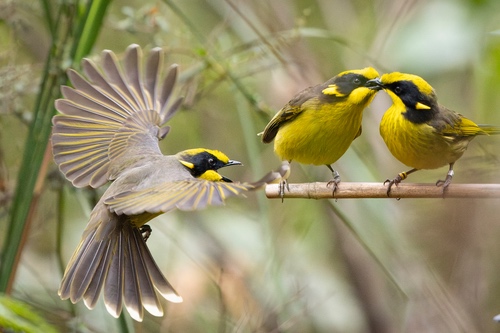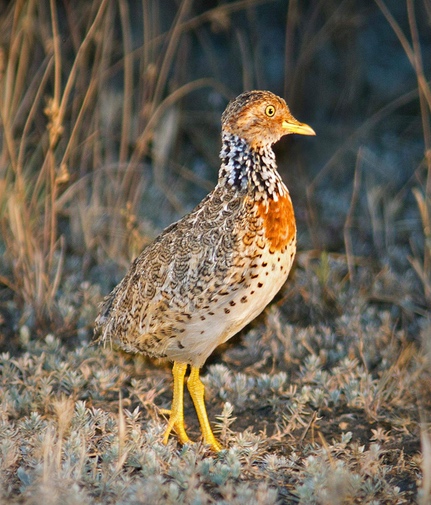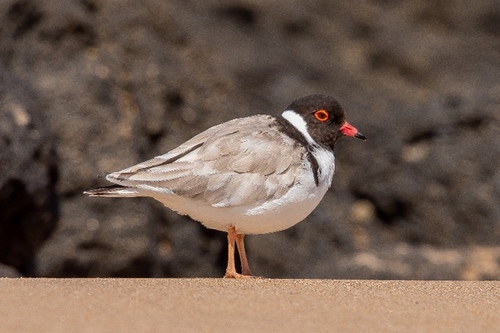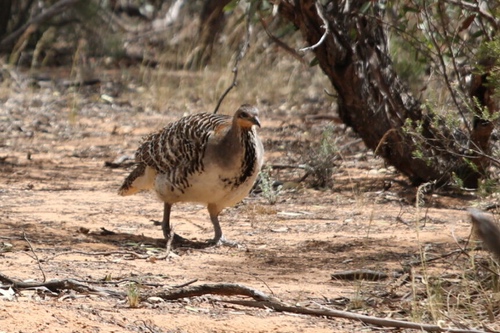
Teams across DEECA work with the latest research, ingenious gadgets, multiple agencies, universities, and dedicated volunteers to foster the right environments for threatened bird species to survive and thrive.
Carrying out in survey work and sharing findings from multiple sources tells researchers that loss of habitat and genetic diversity are the two biggest threats to birds like Malleefowl, the Helmeted Honeyeater, Hooded Plover and Plains-wanderer.
Plains-wanderer
The elusive critically endangered Plains-wanderer is so well camouflaged in its range in the northern grasslands of Victoria that researchers are using song meters to locate them. A network of around 60 song meters, or remote recorders, is set to record the frequency of the female Plains-wanderer's mating call.
Recordings tell researchers where birds are at a given time, which is compared with other data to indicate species' movements and numbers. Covenants are protecting Plains-wanderer habitat on private land. Watch a recent episode of ABC Back Roads to see a covenant on private land in action.

Plains-wanderer (photo: Julian Robinson)
Helmeted Honeyeater
A conservation breeding program at Zoos Victoria is helping to manage genetic diversity and boost Helmeted Honeyeater (or HeHo) numbers. In one of Victoria's most significant threatened species success stories, the release of zoo-bred birds, combined with supplementary feeding in the wild, has seen HeHo numbers more than treble over the past three decades.
Through the work of DEECA and partners' support, the critically endangered Helmeted Honeyeater population has risen to 250 in the wild.

Helmeted Honeyeaters (photo: Jo Howell, Zoos Victoria)
Hooded Plover
Collaborative monitoring and protection measures along Victoria's coast is helping nurture the local Hooded Plover population. When 'hoodies' nest on beaches there is only a 2.5 per cent chance their eggs will survive to be fully-fledged adults, so each breeding season the Conservation Regulator flies into action leading Operation Save Our Hoodies (or SoHo) with support from Parks Victoria, BirdLife Australia and the Great Ocean Road Coast and Parks Authority.
Authorised Officers and volunteers set up exclusion zones around nests and educate beachgoers about keeping alert for and away from the tiny birds and their nests to give them the best chance of survival. In 2022-23, 43 hooded plover chicks survived to become juveniles and more than 1500 people were educated about protecting the beach-nesting bird.
On the Surf Coast, the Great Ocean Road Coast and Parks Authority has overseen a record hoodies season. Thanks to the tireless efforts of volunteers and to beachgoers for respecting exclusion zones and keeping dogs away from breeding areas, five chicks fledged between Torquay and Lorne.

Hooded Plover at the beach
Malleefowl
Mound-building Malleefowl will have a biodiversity corridor through which to move and mix with genetically diverse birds from other areas. Since 2015, revegetation works are connecting Berrook State Forest with Murray Sunset National Park to allow isolated bird populations greater movement and allow the genetic diversity essential for the species' survival.
This year, DEECA established a formal Malleefowl monitoring grid, mapping 74 nests across a 1225-hectare site. Staff and volunteers will monitor the site annually, contributing results to the National Malleefowl Monitoring Program to give a national perspective on population health.

Individual Malleefowl in the wild
Summary
These efforts are part of a comprehensive approach to work towards the recovery and survival of threatened bird species.
The works align with Biodiversity 2037, the Victorian Government's long-term plan to protect the state's precious biodiversity. The plan is being delivered with the Victorian Government's investment of 609 million since 2014 to improve Victoria's natural environment.
For more information, see:
Page last updated: 13/01/25